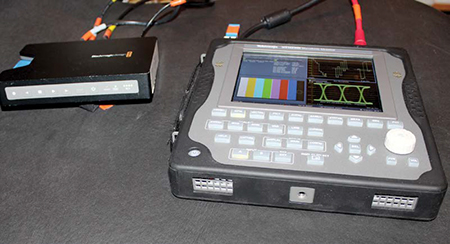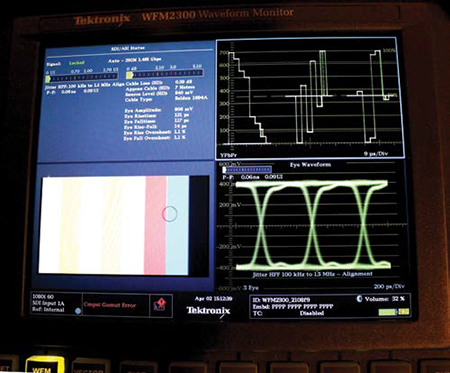Tektronix’s WFM2300 Waveform Monitor
Tektronix has been making monitoring and test gear almost as long as I’ve been around and I’ve certainly used my share, beginning with their 535 lab oscilloscope and 529 waveform monitor; that was a long time ago! Tek has always kept up with, or been slightly ahead of, the times and their new model WFM2300 multiformat multistandard portable waveform monitor is a very good example of the good things that continue to emerge from Beaverton. I was fortunate enough to get to test drive this new model and here are my findings.

The WFM2300 is connected to a Blackmagic Design HyperDeck Shuttle 2 for evaluation in the author’s lab.FEATURES
First off, the WFM2300’s moniker “waveform monitor” is something of a misnomer. Yes, it is a waveform monitor, but it’s also much, much more. In addition to responding to just about every type of video signal you’re likely to encounter in a television facility, the WFM2300 is also a precision measurement device and a source of equally precise video—and audio—test signals. I’d use up all of the space allocated for this review if I tried to list everything the WFM2300 can do, but here are some of the highlights.
On the video side of things, it provides: waveforms, vector presentations, eyepatterns, “lightning” displays, timing information, external reference signals (color black or tri-level), exclusive Tek “diamond” and arrowhead color gamut displays, and a high-definition color picture. I should add that the WFM2300 supports SD/HD/3G SDI video. It automatically detects and responds to video formats under test and when an optional SFP transceiver module is installed it works with optically delivered signals.
Test signals delivered by the WFM2300 include color bars and a pathological signal. These are available in all formats—SD/HD/3G— that the instrument is set up for. Also, Tektronix announced (after I’d returned the evaluation WFM2300) some free updated software that significantly expands the number of video test signals available. Included are checkerboard, pluge and luma reference, ChromaDuMonde, clean aperture and more. Other additions include an option for displaying audio/video delay via a bargraph indicator and propagation delay measurement capability for checking codec latency and similiar applications.
As for audio, the WFM2300 is equally feature rich. It allows on-screen monitoring of up to 16 channels of AES audio and allows users to listen to this via a built-in speaker. In addition to bargraph level indications, the instrument offers multichannel surround and Lissajous audio displays. With suitable options, it can function as a loudness meter, Dolby Guard Band meter, and Dolby metadata decoder and peak level meter. The built-in tone generator provides both embedded and discrete digital audio signals. Dolby E audio signal generation is also available as an option.

The Tektronix WFM2300 displaying internally generated color barsIN USE
As this unit is so feature-rich and has so many menus to drill down through, I confined my initial bench testing to cabling up a “loop back” from the WFM2300’s output port to its input BNC. This allowed me to try out many of the unit’s signal generation and display features while ensuring that nothing could go wrong in terms of an outboard device under test not passing signals and causing confusion and consternation. In this early stage evaluation, I soon discovered there are so many displays and settings that I had to do my “test drive” in several installments. (I should mention here that once you’ve figured out the menu structure, the instrument allows you to store up to 32 test configurations for instant recall, thus saving a lot of time in calling up frequently used test setups.)
Once I felt that I’d mastered most of the WFM2300’s menus, I broke the I/O loop connection I’d set up and brought in an outboard device to take the place of the length of RG-6 coax I’d been using. This was a Blackmagic Design HyperDeck Shuttle 2 capture and playback device.
Once the Shuttle 2 was connected to the WFM2300 and powered up I proceeded to “lay down” several minutes of color bars and tone. Once this was accomplished, I went for playback and while this was in progress I walked through a number of the WFM2300’s display and measurement “pages,” including the very rigorous measurement of all of the SDI signal parameters. Like everyone else making the shift to digital video a number of years ago, I was taught that “digital is perfect,” however, even though the Blackmagic folks have a well-established reputation for perfection in their products, I was sort of hoping for one teeny-tiny parameter to be out of the box, but this wasn’t the case. Even though the Tek WFM2300 gave it a complete workout, nothing in the video output raised even the slightest flag when the “numbers” came in. I next tried the Tek pathological stress test and the Blackmagic box again passed with flying colors. Other testing included synthetically adding some extra cable, which is easily done with the WFM2300, to see if I could push things over the “digital cliff.” No such luck here either. The Shuttle 2 kept on precisely ticking!
Before shutting down the WFM2300 I also tried out its freeze frame capability with some “in motion” video previously captured on the Shuttle 2. I also tried out the cursor-select feature that allows you to very accurately perform measurements on a very small portion of a complex waveform. I won’t go so far as to say that the WFM2300’s measurement possibilities are “endless,” but the user manual is a very thick document.
SUMMARY
Following Tektronix’s very long tradition of building very high quality test gear, the WFM2300 is certainly no slacker. It represents Tek’s latest offering into the world of HDTV and provides just about everything that one could want in test generation and measurement capability. If you’re moving from SDI on copper to fiber, the WFM2300 is ready for this too. The instrument is also firmware-field-upgradable to handle video’s future as it develops. Although I didn’t perform a “drop” test, the device’s housing looks as if it could stand up to most of the abuse offered by studio and field use. The only downside I found was a slight bit of noise from the internal fan (there is a lot of silicon to cool in this compact package), but this was not particularly annoying and really didn’t mask any audio issuing from the unit’s internal speakers. The price tag may make some of us a bit apprehensive, but it’s a very true adage in the world of TV test gear that you get what you pay for. In fact, I still have a Tek 529 waveform monitor and 526 vectorscope in my lab that still perform perfectly despite their having been manufactured about half a century ago!
James O’Neal is a retired broadcast engineer and served as TV Technology’s technology editor from 2005 to 2015. He can be contacted atjonealnb@aol.com.
FAST FACTS
APPLICATION
Wherever a compact and multifeatured test generator and signal display is needed
KEY FEATURES
Compact size, wide variety of signals and displays available
PRICE
$9,950 MSRP
CONTACT
Tektronix
800-833-9200
www.tektronix.com
Get the TV Tech Newsletter
The professional video industry's #1 source for news, trends and product and tech information. Sign up below.
